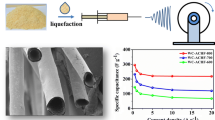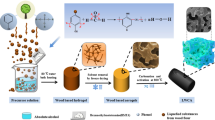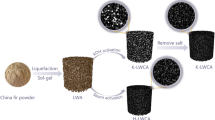Abstract
The heteroatom self-doped activated carbon hollow fibers from liquefied wood (ACHFs) were prepared by melt spinning, half-curing, carbonization and activation using steam. The results showed that the ACHFs with N and P doping exhibited high specific surface area (1896.6–2040.8 m2g−1) and total pore volume (1.02–1.058 cm3g−1). It was also found that the mechanisms of P from catalyst and N from curing agent were different in the formation of pore structure of ACHFs. When applied to supercapacitor, the ACHF-N10P16 can deliver a high specific capacitance of 151 F g−1 at current density of 1 A g−1 in 6 M KOH electrolyte. In addition, ACHFs displayed the synergistic advantages of pseudo-capacitance and double-layer capacitance because of N and P doping. As a result, the ACHFs with adjustable heteroatom doping have a broad application prospect in electrochemical energy storage.





Similar content being viewed by others
References
An KH, Kim WS, Park YS, Moon JM, Bae DJ, Lim SC, Lee YS, Lee YH (2001) Electrochemical properties of high-power supercapacitors using single-walled carbon nanotube electrodes. Adv Funct Mater 11:387–392
Barman BK, Nanda KK (2018) CoFe nanoalloys encapsulated in N-doped graphene layers as a Pt-free multifunctional robust catalyst: elucidating the role of co-alloying and N-doping. ACS Sustain Chem Eng 6:12736–12745
Chen J, Lang Z, Xu Q, Zhang J, Fu J, Chen Z (2013) A novel method to fabricate discrete porous carbon hemispheres and their electrochemical properties as supercapacitors. Phys Chem Chem Phys 15:17786–17792
Frackowiak E (2007) Carbon materials for supercapacitor application. Phys Chem Chem Phys 9:1774–1785
Ganesan A, Mukherjee R, Raj J, Shaijumon MM (2014) Nanoporous rice husk derived carbon for gas storage and high performance electrochemical energy storage. J Porous Mater 21:839–847
Inagaki M (2009) Pores in carbon materials-importance of their control. New Carbon Mater 24:193–232
Li Z, Zhang L, Amirkhiz BS, Tan X, Xu Z, Wang H, Olsen BC, Holt CM, Mitlin D (2012) Carbonized chicken eggshell membranes with 3D architectures as high-performance electrode materials for supercapacitors. Adv Energy Mater 2:431–437
Li L, Zhou Y, Zhou H, Qu H, Zhang C, Guo M, Liu X, Zhang Q, Gao B (2018) N/P codoped porous carbon/one-dimensional hollow tubular carbon heterojunction from biomass inherent structure for supercapacitors. ACS Sustain Chem Eng 7:1337–1346
Liu Y, Huang B, Lin X, Xie Z (2017) Biomass-derived hierarchical porous carbons: boosting the energy density of supercapacitors via an ionothermal approach. J Mater Chem A 5:13009–13018
Long C, Chen X, Jiang L, Zhi L, Fan Z (2015) Porous layer-stacking carbon derived from in-built template in biomass for high volumetric performance supercapacitors. Nano Energy 12:141–151
Ma X, Guangjie Z (2010) Preparation of carbon fibers from liquefied wood. Wood Sci Technol 44:3–11
Ma X, Zhang F, Zhu J, Yu L, Liu X (2014) Preparation of highly developed mesoporous activated carbon fiber from liquefied wood using wood charcoal as additive and its adsorption of methylene blue from solution. Bioresour Technol 164:1–6
Panja T, Bhattacharjya D, Yu J-S (2015) Nitrogen and phosphorus co-doped cubic ordered mesoporous carbon as a supercapacitor electrode material with extraordinary cyclic stability. J Mater Chem A 3:18001–18009
Park SK, Kwon SH, Lee SG, Choi MS, Suh DH, Nakhanivej P, Lee H, Park HS (2018) 105 cyclable pseudocapacitive Na-ion storage of hierarchically structured phosphorus-incorporating nanoporous carbons in organic electrolytes. ACS Energy Lett 3:724–732
Sodtipinta J, Ieosakulrat C, Poonyayant N, Kidkhunthod P, Chanlek N, Amornsakchai T, Pakawatpanurut P (2017) Interconnected open-channel carbon nanosheets derived from pineapple leaf fiber as a sustainable active material for supercapacitors. Ind Crop Prod 104:13–20
Tan G, Bao W, Yuan Y, Liu Z, Shahbazian-Yassar R, Wu F, Amine K, Wang J, Lu J (2017) Freestanding highly defect nitrogen-enriched carbon nanofibers for lithium ion battery thin-film anodes. J Mater Chem A 5:5532–5540
Wang Q, Yan J, Fan Z (2016) Carbon materials for high volumetric performance supercapacitors: design, progress, challenges and opportunities. Energy Environ Sci 9:729–762
Wu X, Xing W, Florek J, Zhou J, Wang G, Zhuo S, Xue Q, Yan Z, Kleitz F (2014) On the origin of the high capacitance of carbon derived from seaweed with an apparently low surface area. J Mater Chem A 2:18998–19004
Wu X, Zhou J, Xing W, Zhang Y, Bai P, Xu B, Zhuo S, Xue Q, Yan Z (2015) Insight into high areal capacitances of low apparent surface area carbons derived from nitrogen-rich polymers. Carbon 94:560–567
Xu B, Wu F, Chen R, Cao G, Chen S, Zhou Z, Yang Y (2008) Highly mesoporous and high surface area carbon: a high capacitance electrode material for EDLCs with various electrolytes. Electrochem Commun 10:795–797
Yan L, Yu J, Houston J, Flores N, Luo H (2017) Biomass derived porous nitrogen doped carbon for electrochemical devices. Green Energy Environ 2:84–99
Yu M, Han Y, Li J, Wang L (2017) CO2-activated porous carbon derived from cattail biomass for removal of malachite green dye and application as supercapacitors. Chem Eng J 317:493–502
Zhang LL, Zhou R, Zhao X (2010) Graphene-based materials as supercapacitor electrodes. J Mater Chem 20:5983–5992
Zhang ZJ, Zheng QC, Sun L, Xu D, Chen XY (2017) Two-dimensional carbon nanosheets for high-performance supercapacitors: large-scale synthesis and codoping with nitrogen and phosphorus. Ind Eng Chem Res 56:12344–12353
Zhao L, Fan LZ, Zhou MQ, Guan H, Qiao S, Antonietti M, Titirici MM (2010) Nitrogen-containing hydrothermal carbons with superior performance in supercapacitors. Adv Mater 22:5202–5206
Acknowledgements
The authors are grateful for the financial supports from National Natural Science Foundation of China (No. 31870564) and the Science Foundation of Tianjin Municipal Education Commission (2019ZD039).
Author information
Authors and Affiliations
Corresponding author
Ethics declarations
Conflict of interest
The authors declare that they have no known competing financial interests or personal relationships that could have appeared to influence the work reported in this paper.
Additional information
Publisher's Note
Springer Nature remains neutral with regard to jurisdictional claims in published maps and institutional affiliations.
Rights and permissions
About this article
Cite this article
Wang, L., Ma, X. Preparation of N, P self-doped activated carbon hollow fibers derived from liquefied wood. Wood Sci Technol 55, 83–93 (2021). https://doi.org/10.1007/s00226-020-01244-8
Received:
Accepted:
Published:
Issue Date:
DOI: https://doi.org/10.1007/s00226-020-01244-8




